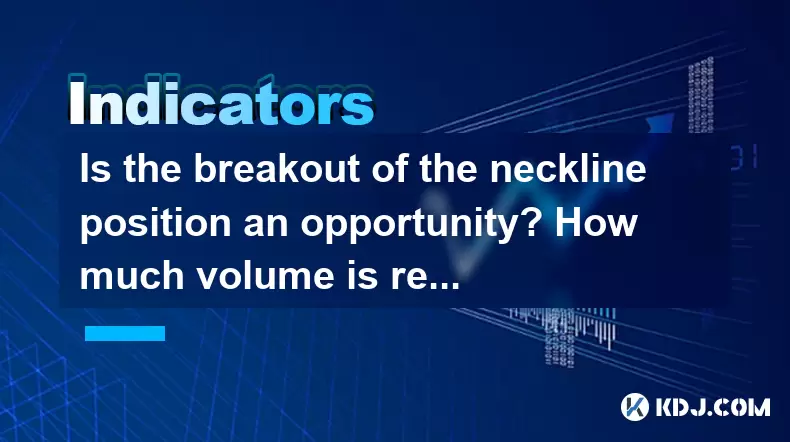-
 bitcoin
bitcoin $123963.239194 USD
1.37% -
 ethereum
ethereum $4529.082464 USD
1.07% -
 xrp
xrp $2.983640 USD
0.71% -
 tether
tether $1.000287 USD
0.02% -
 bnb
bnb $1179.874393 USD
2.99% -
 solana
solana $230.633678 USD
1.55% -
 usd-coin
usd-coin $0.999835 USD
0.03% -
 dogecoin
dogecoin $0.254240 USD
1.34% -
 tron
tron $0.341176 USD
0.15% -
 cardano
cardano $0.842285 USD
0.52% -
 hyperliquid
hyperliquid $48.537896 USD
-0.86% -
 chainlink
chainlink $21.863092 USD
-0.84% -
 ethena-usde
ethena-usde $0.999743 USD
-0.07% -
 sui
sui $3.579561 USD
-0.18% -
 stellar
stellar $0.403418 USD
2.67%
Is the breakout of the neckline position an opportunity? How much volume is required?
A neckline breakout in crypto trading, often signaled by high volume, can indicate strong market shifts and trading opportunities, but requires careful validation.
Jun 02, 2025 at 01:49 am

The breakout of the neckline position in the context of cryptocurrency trading is often seen as a significant event that can signal potential trading opportunities. The neckline is a critical level in chart patterns such as head and shoulders, inverse head and shoulders, and double or triple tops and bottoms. When the price breaks through this level, it can indicate a strong shift in market sentiment and potential for substantial price movements. However, to capitalize on such breakouts, traders must understand the volume requirements and other factors that validate the breakout.
Understanding the Neckline in Cryptocurrency Trading
The neckline is a horizontal line drawn at the level of the lows (or highs) in a specific chart pattern. In a head and shoulders pattern, for example, the neckline connects the lows of the two shoulders. A breakout occurs when the price moves decisively above or below this line, suggesting a change in the trend. For traders, this can represent an entry point for a new position or an exit point for an existing one.
The Importance of Volume in Validating Breakouts
Volume plays a crucial role in confirming the validity of a neckline breakout. High volume during a breakout indicates strong interest and conviction among traders, increasing the likelihood that the breakout will lead to a sustained price move. Conversely, a breakout on low volume may be less reliable and could result in a false breakout, where the price quickly reverses back to its previous range.
How Much Volume is Required for a Valid Breakout?
Determining the exact volume required for a valid breakout can be challenging, as it depends on various factors including the specific cryptocurrency, the overall market conditions, and the historical trading volume of the asset. However, a general rule of thumb is that the volume during the breakout should be significantly higher than the average volume over the preceding period. A common benchmark is that the breakout volume should be at least 50% higher than the 30-day average volume.
Steps to Identify and Trade a Neckline Breakout
To effectively trade a neckline breakout, follow these steps:
- Identify the Pattern: Use technical analysis tools to identify a head and shoulders, inverse head and shoulders, or other patterns that feature a neckline.
- Draw the Neckline: Connect the relevant lows or highs to form the neckline on your chart.
- Monitor Volume: Keep an eye on the trading volume as the price approaches the neckline. A significant increase in volume as the price breaks through the neckline can confirm the breakout.
- Set Entry and Exit Points: Once the breakout is confirmed, set your entry point just above (or below) the neckline for a long (or short) position. Also, determine your exit points, including stop-loss and take-profit levels, based on your risk management strategy.
- Execute the Trade: Enter the trade once the breakout is confirmed by volume and price movement. Monitor the trade closely to manage your position according to your plan.
Analyzing the Strength of a Breakout
The strength of a breakout can be assessed by several factors beyond just volume. Consider the following:
- Price Movement: A strong breakout should be accompanied by a significant and sustained price move away from the neckline.
- Candlestick Patterns: Look for bullish or bearish candlestick patterns that reinforce the breakout direction.
- Market Sentiment: Assess the overall market sentiment and news that may influence the cryptocurrency's price movement.
Potential Risks and Considerations
While a neckline breakout can present lucrative trading opportunities, it is essential to be aware of the risks involved. False breakouts are common, where the price briefly moves past the neckline but then reverses back into the previous range. To mitigate this risk, traders should use stop-loss orders to limit potential losses. Additionally, consider the volatility of the cryptocurrency market, which can lead to rapid price changes and increased risk.
Practical Example of a Neckline Breakout
Let's consider a practical example of a neckline breakout in Bitcoin (BTC). Suppose you identify a head and shoulders pattern on the BTC/USD chart, with the neckline drawn at $30,000. As the price approaches the neckline, you notice that the trading volume starts to increase significantly. When the price finally breaks through the $30,000 level, the volume is 70% higher than the 30-day average. This confirms the breakout, and you decide to enter a long position at $30,100, setting a stop-loss at $29,900 and a take-profit at $32,000.
Tools and Resources for Tracking Volume and Breakouts
To effectively track volume and identify breakouts, traders can use various tools and resources:
- Trading Platforms: Platforms like Binance, Coinbase Pro, and Kraken offer real-time charts and volume data.
- Technical Analysis Software: Tools such as TradingView and MetaTrader provide advanced charting capabilities and indicators for identifying patterns and breakouts.
- Cryptocurrency Data Websites: Websites like CoinMarketCap and CoinGecko offer historical and real-time data on cryptocurrency volumes and prices.
Frequently Asked Questions
Q1: Can a neckline breakout occur without a significant volume increase?A1: While it is possible for a neckline breakout to occur without a significant volume increase, such breakouts are less reliable and more likely to result in false signals. A breakout with low volume may indicate a lack of conviction among traders, increasing the risk of a price reversal.
Q2: How long should I wait to confirm a neckline breakout?A2: The confirmation of a neckline breakout can vary depending on the specific cryptocurrency and market conditions. A common approach is to wait for the price to close above (or below) the neckline on a daily or 4-hour chart, accompanied by a significant volume increase. This can help filter out false breakouts and increase the likelihood of a sustained price move.
Q3: What are some common mistakes traders make when trading neckline breakouts?A3: Some common mistakes include entering a trade too early without waiting for volume confirmation, setting stop-losses too tight which can result in premature exits, and failing to consider the overall market context and news that may impact the cryptocurrency's price. Additionally, traders often overlook the importance of risk management and position sizing, which can lead to significant losses.
Q4: How can I improve my skills in identifying and trading neckline breakouts?A4: To improve your skills, practice using demo accounts to trade breakouts without risking real money. Study historical charts to identify patterns and understand how volume and price interact during breakouts. Additionally, keep up with market news and sentiment, and use technical analysis tools to refine your trading strategy. Joining trading communities and forums can also provide valuable insights and feedback from experienced traders.
Disclaimer:info@kdj.com
The information provided is not trading advice. kdj.com does not assume any responsibility for any investments made based on the information provided in this article. Cryptocurrencies are highly volatile and it is highly recommended that you invest with caution after thorough research!
If you believe that the content used on this website infringes your copyright, please contact us immediately (info@kdj.com) and we will delete it promptly.
- BlockDAG, DOGE, HYPE Sponsorship: Crypto Trends Shaping 2025
- 2025-10-01 00:25:13
- Deutsche Börse and Circle: A StableCoin Adoption Powerhouse in Europe
- 2025-10-01 00:25:13
- BlockDAG's Presale Buzz: Is It the Crypto to Watch in October 2025?
- 2025-10-01 00:30:13
- Bitcoin, Crypto, and IQ: When Genius Meets Digital Gold?
- 2025-10-01 00:30:13
- Stablecoins, American Innovation, and Wallet Tokens: The Next Frontier
- 2025-10-01 00:35:12
- NBU, Coins, and Crypto in Ukraine: A New Yorker's Take
- 2025-10-01 00:45:14
Related knowledge

What is a tower bottom candlestick pattern? Does it have a high success rate?
Sep 22,2025 at 07:18am
Tower Bottom Candlestick Pattern Explained1. The tower bottom candlestick pattern is a reversal formation that typically appears at the end of a downt...

What is a black hole pattern in the MACD indicator? Is it a cause for concern?
Sep 21,2025 at 06:54pm
Bitcoin's Role in Decentralized Finance1. Bitcoin remains the cornerstone of decentralized finance, serving as a benchmark for value and security acro...

How can I use the psychological line (PSY) to determine market sentiment?
Sep 17,2025 at 02:19pm
Understanding the Psychological Line (PSY) in Cryptocurrency TradingThe Psychological Line, commonly referred to as PSY, is a momentum oscillator used...

How can I determine if a double top pattern has officially formed?
Sep 21,2025 at 03:18am
Understanding the Structure of a Double Top Pattern1. A double top pattern consists of two distinct peaks that reach approximately the same price leve...

What is the Golden Valley pattern on the moving average? Is it better than the Silver Valley pattern?
Sep 21,2025 at 02:54pm
Understanding the Golden Valley Pattern in Moving Averages1. The Golden Valley pattern is a technical formation observed in cryptocurrency price chart...

What does a death cross of the RSI in the strong zone (above 50) mean?
Sep 17,2025 at 10:54pm
Understanding the Death Cross in RSI Context1. The term 'death cross' is traditionally associated with moving averages, where a short-term average cro...

What is a tower bottom candlestick pattern? Does it have a high success rate?
Sep 22,2025 at 07:18am
Tower Bottom Candlestick Pattern Explained1. The tower bottom candlestick pattern is a reversal formation that typically appears at the end of a downt...

What is a black hole pattern in the MACD indicator? Is it a cause for concern?
Sep 21,2025 at 06:54pm
Bitcoin's Role in Decentralized Finance1. Bitcoin remains the cornerstone of decentralized finance, serving as a benchmark for value and security acro...

How can I use the psychological line (PSY) to determine market sentiment?
Sep 17,2025 at 02:19pm
Understanding the Psychological Line (PSY) in Cryptocurrency TradingThe Psychological Line, commonly referred to as PSY, is a momentum oscillator used...

How can I determine if a double top pattern has officially formed?
Sep 21,2025 at 03:18am
Understanding the Structure of a Double Top Pattern1. A double top pattern consists of two distinct peaks that reach approximately the same price leve...

What is the Golden Valley pattern on the moving average? Is it better than the Silver Valley pattern?
Sep 21,2025 at 02:54pm
Understanding the Golden Valley Pattern in Moving Averages1. The Golden Valley pattern is a technical formation observed in cryptocurrency price chart...

What does a death cross of the RSI in the strong zone (above 50) mean?
Sep 17,2025 at 10:54pm
Understanding the Death Cross in RSI Context1. The term 'death cross' is traditionally associated with moving averages, where a short-term average cro...
See all articles










































































